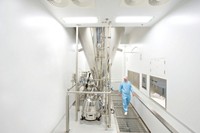Advertisement
Grab your lab coat. Let's get started
Welcome!
Welcome!
Create an account below to get 6 C&EN articles per month, receive newsletters and more - all free.
It seems this is your first time logging in online. Please enter the following information to continue.
As an ACS member you automatically get access to this site. All we need is few more details to create your reading experience.
Not you? Sign in with a different account.
Not you? Sign in with a different account.
ERROR 1
ERROR 1
ERROR 2
ERROR 2
ERROR 2
ERROR 2
ERROR 2
Password and Confirm password must match.
If you have an ACS member number, please enter it here so we can link this account to your membership. (optional)
ERROR 2
ACS values your privacy. By submitting your information, you are gaining access to C&EN and subscribing to our weekly newsletter. We use the information you provide to make your reading experience better, and we will never sell your data to third party members.
Pharmaceuticals
Collaborative Research: Irish Experts Converge On Problems In Pharmaceutical Crystallization
by Rick Mullin
July 19, 2010
| A version of this story appeared in
Volume 88, Issue 29
“We have tried to develop a community of practice in the area of crystallization of pharmaceuticals,” says Kieran Hodnett, dean of the Faculty of Science & Engineering at the University of Limerick and lead principal investigator for SSPC, which was launched in 2007. “We wanted to get all the expertise available in Ireland together to work on generic problems related to powder technology.”
Funded by Science Foundation Ireland (SFI), a government body established in 2003, SSPC has signed on most of Ireland’s major research institutions, including Limerick, Trinity College, University College Cork, University College Dublin, and the National University of Ireland, in Galway. And nearly all the major drug companies manufacturing in Ireland are also participating.
Polymorph chemistry is a hot topic in Ireland, given the number of companies working on drug formulation, according to Mary Shire, director of research support services at Limerick. Shire, who worked in industry before taking the position at Limerick in 2005, says SSPC addresses one of the biggest hurdles confronting Irish facilities that launch new drugs.
“Most of the challenges we saw in moving products to manufacturing were in the crystallization stage,” she says, noting that the R&D supporting manufacturing in the country is often done in the U.S., Europe, or Japan. “The chemists there don’t focus on crystallization, and when the process arrives in Ireland, it becomes an issue in scale-up. When I joined the university and saw they had expertise in crystallization, I said, ‘Look, this is something industry needs.’ ”
Shire discussed the possibility of obtaining funding for an industry-academia research cluster with Hodnett, who has directed a collaboration on crystallization between the university and alumina firm Aughinish Alumina. “I made the pitch that this is an industry hugely important to the Irish economy, and I felt the university sector was not doing enough,” Shire recalls.
Hodnett and Shire then pitched the idea to SFI, which gave them only a few weeks to bring industry partners together, Hodnett says. “It was remarkable, actually,” he says. “We visited 10 companies and nine signed up.”
The program received funding for five years, with approximately $9 million from SFI and more than $2 million from industrial partners. It will be reviewed for further funding in September. By then, Hodnett says, SSPC will be moving into phase two, in which academic researchers will team with companies on specific projects.
SSPC is already focusing on frontier science, Hodnett says, most significantly in the area of continuous crystallization. “The producers are very interested in continuous processing,” he says, “but what hasn’t been cracked at all is how to do continuous crystallization in pharmaceuticals in a manner that is efficient and manageable. There is microfluidics, but very little has been done with powders.”
Although companies have long been interested in accessing academic know-how individually, consensus is growing that it makes sense to pool efforts, explains Jon O’Halloran, project manager for SSPC. Headway has been made in getting industry and academic researchers to “speak the same language,” says O’Halloran, who also worked in industry.
Guy Villax, chief executive officer of Hovione, the Portuguese pharmaceutical chemical maker that recently purchased a Pfizer plant in Cork, says researchers at Hovione’s headquarters are active with SSPC. “We are interested in particle design and staying current with the state of the art,” Villax says. The consortium is valuable to Hovione, he says, adding, “We do not want to miss the boat.”
As an academic, Hodnett says he is impressed with the level of scientific know-how among SSPC’s industrial partners. “The pharma industry in Ireland is populated with organic chemists who are already good at making the molecule,” he says. “One of the things I obsess with is the mechanism of polymorphism. The only thing I ask is that the industry bring us interesting problems.”






Join the conversation
Contact the reporter
Submit a Letter to the Editor for publication
Engage with us on Twitter